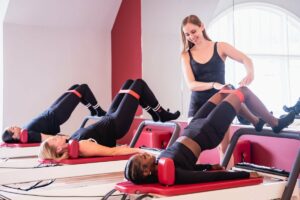 Pilates is a great workout option for people of any age or ability level. However, what participants get out of the class is not just tied to them and how well they do the exercises; it also comes down to accessible, friendly instruction.
Pilates is a great workout option for people of any age or ability level. However, what participants get out of the class is not just tied to them and how well they do the exercises; it also comes down to accessible, friendly instruction.
To effectively train and guide others in Pilates, instructors must first be confident in their own skills and focus on delivering clear, friendly, and encouraging instruction that’s easy for others to follow. No one wants to listen to an instructor who is condescending, unsure, or moves too fast!
In addition, good Pilates instructors understand that while the exercises might be the same across age groups, the way they are taught may need to be amended based on who is in the class.
While most classes consist of adults of all ages, it is good to keep in mind how to help people add challenges or modifications when needed to cater to each individual in the class.
Here are some tips for teaching Pilates to different age groups that help everyone have a good time and get the most out of their effort.
Teaching Pilates to Young Adults
When teaching Pilates to young participants, the focus should be on fun and ease of understanding. Remember: participants must be at least 16 years of age to participate, as it is not safe to use a reformer before this time. A few things to keep in mind:
- Younger participants are still developing their ability to focus and concentrate. They may become restless if locked into an exercise for multiple minutes at a time.
- When teaching to a younger audience, you may notice they are still developing that mind-body connection. Demonstrating exercises and hands on correction helps them to find the right alignment and placement of their bodies during exercises.
- Reformer Pilates may be difficult if young adults are not tall enough. To avoid awkward situations make sure to educate clients on how reformers and exercises can be adjusted for shorter teens!
Teaching Pilates to the Middle-Aged Groups
Middle-aged adults make up the majority of Pilates participants, especially when doing Reformer Pilates. While adults typically adjust faster to taking class than teens, they have some of their own challenges.
 Instructors should be willing to gently correct participants, both in terms of posture or execution and also focus. Some adults respond more amenably than others to such correction, making it important to consider multiple methods of correction depending on the personality of the participant.
Instructors should be willing to gently correct participants, both in terms of posture or execution and also focus. Some adults respond more amenably than others to such correction, making it important to consider multiple methods of correction depending on the personality of the participant.- Do not be afraid to educate, not just demonstrate. Many adults have never encountered an explanation of how their body works to this degree, and they want to learn.
- Listen to participants. An instructor may come into the room with a goal for a certain type of movement, but not every participant may be able to achieve that movement. Listen to the needs of each participant and help them find the adjustments that work for them and their body.
- Remain encouraging. It is easy to compare oneself to other people in the class, we are all on our own, individualized path!
Pilates Instruction for Older Individuals
Pilates is not off-limits to older folks! In fact, it can be a great way to regain or retain flexibility and stability in older age, reducing the risk of dangerous falls and other injuries. However, Pilates instructors should approach classes with older individuals with a couple extra concepts in mind.
- Be especially attentive to limited abilities. This age group is more likely to have greater challenges with movement range, the ability to bend, and balance. Select exercises that keep people safe.
- Choose equipment that supports seniors. For example, the box adds a lot more support when holding a plank. Try to avoid movements that require putting direct pressure on knees and wrists, or offer modifications.
- Keep the studio accessible. Pilates instructors often like to use music to entertain and keep participants engaged during exercises, but loud music can interfere with instruction for older folks with hearing impairment. Wearing a microphone to project your voice can be helpful!
- Consider changing springs to provide more support, or for standing exercises, holding the gondola pole.
- Offer breaks. Older adults may no longer have the endurance they once did, or pain flare-ups may interfere with the ability to continue uninterrupted for 50 minutes. Short breaks need not be completely devoid of activity! Try breathing exercises, stretching, or even self-reflection to keep their minds engaged while their body recovers.
Embrace Pilates Instruction to Teach at Your Best

Teaching Pilates can be a rich and rewarding experience, and participants rely on good instructors to get the most out of their workouts. If you are considering becoming a Pilates instructor yourself, consider how the age of your class participants may impact how well they can engage with the material—and how you can shape your class to get the greatest benefit from their abilities.
The experts at RTR Pilates can offer insight into how to craft a great reformer Pilates class for participants of any age. Contact RTR Pilates to sign up for a class and see how it’s done!



